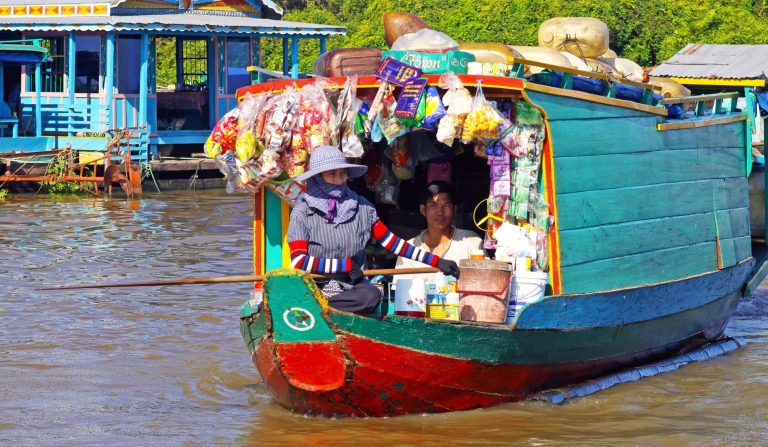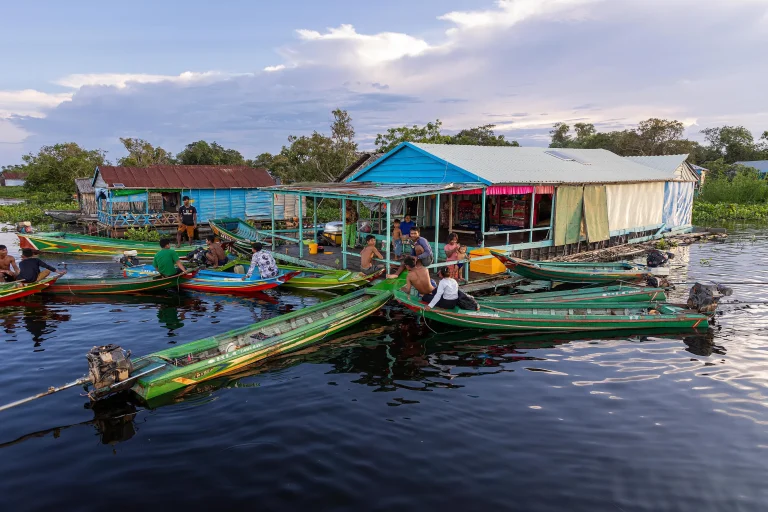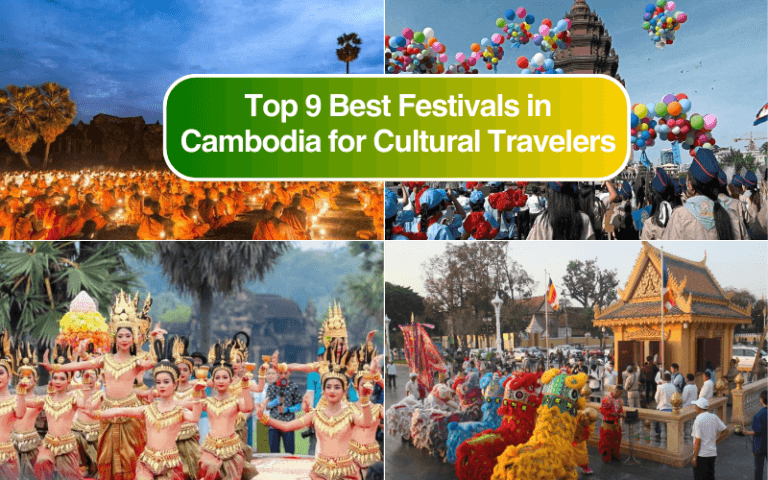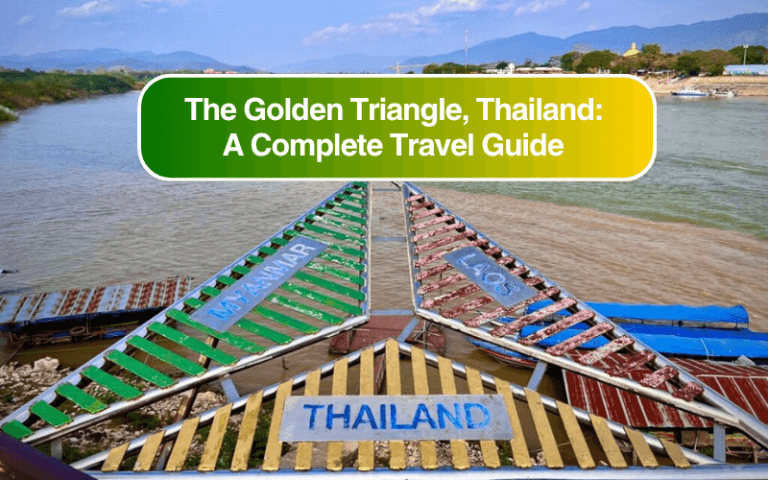 All Our Tours
All Our Tours
Written by: Alice Le
Updated date:07/02/2025
Contents
Tonle Sap Lake is one of Cambodia’s most iconic natural landmarks and a UNESCO Biosphere Reserve. It’s a place where nature, culture, and wildlife come together, making it a must-see destination for travelers exploring the Kingdom of Wonder. In this post, we’ll cover essential travel information, tips, and interesting facts about Tonle Sap Lake.
1. Where is Tonle Sap Lake?Tonle Sap is a large freshwater lake located in the central region of Cambodia, just to the south of Siem Reap. It is the largest lake in Southeast Asia, covering up to 2,500 square kilometers in the wet season, and it is a crucial water source for millions of people living in Cambodia. The lake is also part of the Tonle Sap River, which connects to the mighty Mekong River to the south, in Phnom Penh. The ecosystem around the lake is vital for local fishing communities, as well as providing a rich habitat for migratory birds and aquatic life.  Tonle-Sap-Lake-Cambodia 2. How to Get from Siem Reap to Tonle Sap Lake?Getting to Tonle Sap Lake from Siem Reap is relatively straightforward, and there are several transport options to choose from depending on your preferences, time constraints, and the time of year you’re visiting. 2.1. By Boat (The Most Scenic Option)One of the most popular and enjoyable ways to visit Tonle Sap Lake is by boat. A boat ride provides an opportunity to experience the stunning scenery up close, passing through the floating villages that line the lake. These villages, which are home to local communities living in stilt houses, are a truly unique sight. As you glide across the water, you’ll witness the everyday life of residents, from children playing in the water to fishermen casting their nets. It’s a beautiful way to immerse yourself in the culture and natural beauty of the lake. The two most commonly used departure points for boat tours are Chong Kneas and Kampong Phluk docks, both of which are located within easy reach of Siem Reap. The boat ride typically takes around 1 hour, covering a distance of about 15 to 20 kilometers from Siem Reap, depending on the dock you depart from. Along the way, you’ll enjoy breathtaking views of the expansive water and the surrounding lush landscape.
2.2. By Taxi or Tuk-Tuk (Quick and Direct)If you’re looking for a more direct route to Tonle Sap Lake, hiring a taxi or tuk-tuk is a good option. While you won’t get the scenic boat ride through the floating villages, this method will take you straight to the lakeside communities or docks, where you can board a boat if desired. From Siem Reap, it takes approximately 30 to 40 minutes to reach the lake, depending on traffic and the specific dock you’re heading to. This option is especially convenient if you’re short on time or simply prefer a faster journey. You can negotiate a fixed fare with a tuk-tuk driver or taxi, though prices can vary depending on your final destination and the type of vehicle.
 where is tonle sap lake 3.Best Time to Visit Tonle Sap LakeTonle Sap Lake is a year-round destination, but the experience you’ll have can vary greatly depending on when you choose to visit. The lake is uniquely affected by seasonal changes, which means the best time to visit really depends on your interests. Whether you’re looking to explore the lake’s shorelines, witness the thriving wildlife, or immerse yourself in the local culture, each season offers something special. The Dry Season (November to March)The dry season, spanning from November to March, is widely considered the most comfortable time to visit Tonle Sap Lake. During these months, the weather is cooler, less humid, and more conducive to outdoor activities, making it ideal for sightseeing and photography. This period is marked by dry, sunny days and pleasant temperatures, typically ranging from 25°C to 30°C. It’s a great time for exploring the floating villages or taking boat rides on the lake, as the weather is more stable and rain is infrequent. One of the most noticeable changes during the dry season is the shrinking of the lake’s size. As the water levels drop, the surface area of Tonle Sap contracts significantly, revealing the stilted homes of the local fishing communities. You’ll be able to see the unique architecture of the floating villages as they are more visible from land, and walking through these communities offers a different perspective on local life. Moreover, the dry season is perfect for those interested in exploring the lake’s shorelines, visiting the floating villages, or enjoying the scenic boat rides without the interruptions of rain. It’s also an excellent time for travelers who prefer cooler, more manageable weather for outdoor excursions, especially during the daytime.  Tonle Sap lake floating village The Wet Season (May to October)The wet season, from May to October, offers a completely different experience. While the weather tends to be hot and rainy, the landscape during this time is lush, vibrant, and filled with an abundance of wildlife. This is the time when the lake is at its fullest, providing a dramatic change in scenery. In this season, the temperatures reach 30°C to 35°C, and afternoon showers are common, but they often come in quick bursts, allowing for sunny spells between rainstorms. The humidity levels are higher, and while the rains may make some activities less predictable, the overall experience is rich and dynamic. During the rainy season, Tonle Sap swells to its maximum size, covering a vast area and reaching far into the surrounding forests. The water levels rise significantly as the Tonle Sap River reverses its flow, flooding the lake and surrounding wetlands. This provides a unique opportunity to explore the lake as it extends into forested areas, creating an almost mystical environment. The expansive waters allow boats to navigate through flooded forests, offering a rare glimpse into the region’s ecology and wildlife. In addition, the wet season is particularly great for wildlife enthusiasts, especially bird watchers. Migratory birds, including many endangered species, flock to the lake during these months, making it an exceptional time for birdwatching. The lush, green landscape also attracts a variety of animal species, and you may even see wildlife such as water buffalo, otters, and crocodiles in their natural habitat. Whether you choose to visit Tonle Sap Lake during the dry or wet season, you’ll be able to witness the lake’s extraordinary natural beauty and vibrant culture. The dry season offers calm weather and clear views of the floating villages, while the wet season presents a dynamic, lush landscape teeming with wildlife. Whatever your interests—whether it’s exploring local life, experiencing nature, or enjoying peaceful boat rides—there’s always something special to see and do at Tonle Sap. 4. What to Do in Tonle Sap?Tonle Sap Lake offers visitors a variety of activities that showcase both its natural beauty and cultural significance so tourists can have a lot of interesting experiences in this destination.  Tonle Sap lake ecosystem 4.1. Visit the Floating Villages and MarketsTonle Sap is home to several floating villages, where entire communities live in homes built on stilts above the water. Some of the most famous floating villages include Chong Kneas, Kampong Phluk, and Kampong Khleang. When visiting the floating villages, tourists will take a boat ride to visit these villages, interact with the locals and see floating schools, floating markets, and fishing boats, all while learning about the unique lifestyle of the inhabitants. In addition, in the early morning, local villagers from Tonle Sap Lake bring their goods to the floating markets. It’s a fascinating experience where you can see fresh fish, vegetables, and local produce being sold on boats. 4.2.Explore the Tonle Sap Biosphere ReserveThis UNESCO Biosphere Reserve is home to a diverse range of wildlife, including rare birds like the painted stork and Indian spot-billed duck. Birdwatching is especially popular here, particularly during the dry season when birds flock to the area. Participating in a bird-watching tour or taking a guided boat trip through the reserve will be an amazing experience for tourists, you can also spot water buffalo, fishing eagles, and perhaps even crocodiles! 4.3. Kayaking and CanoeingFor a more intimate experience, travelers can rent a kayak or canoe and paddle through the lake’s waters. This activity is perfect for nature lovers and gives you a closer look at the surrounding wildlife and floating villages. 5. Tonle Sap Lake FactsTonle Sap Lake is a wonderful place with a lot of fascinating facts that will deepen your appreciation for this unique Cambodian landmark: 5.1. It’s the Largest Freshwater Lake in Southeast AsiaTonle Sap Lake is not only the largest in Cambodia but also in Southeast Asia, with an area that can expand to up to 2,500 square kilometers during the wet season. 5.2. It’s Vital for Cambodia’s EconomyThe lake supports over 3 million people, many of whom rely on fishing as their primary source of income. Tonle Sap is one of the most productive freshwater fisheries in the world, providing food and livelihoods to thousands of Cambodians.  Cambodia Tonle Sap lake facts 5. 3. It Expands and Contracts SeasonallyOne of the most unique features of Tonle Sap is its seasonal transformation. During the rainy season, the Tonle Sap River reverses its flow, causing the lake to expand as it fills with water from the Mekong River. During the dry season, the water recedes, and the lake becomes smaller. 5.4. A UNESCO Biosphere ReserveThe Tonle Sap Biosphere Reserve, which encompasses the lake and surrounding wetlands, was designated a UNESCO Biosphere Reserve in 1997. It’s an internationally recognized area for its biodiversity and ecological importance. 5.5. Unique Floating VillagesThe floating villages of Tonle Sap are home to various ethnic groups, including the Khmer, Vietnamese, and Cham. These communities live in houses built on stilts to cope with the seasonal changes in water levels. 5.6. Rich BirdlifeTonle Sap is an essential stopover for migratory birds traveling through Southeast Asia. The lake and surrounding wetlands are home to over 200 species of birds, making it an important location for birdwatching. ConclusionTonle Sap Lake is a unique and breathtaking part of Cambodia, offering an authentic experience of the country’s natural beauty and rich cultural heritage. Whether you’re visiting to explore its floating villages, engage in wildlife viewing, or simply soak in the peaceful atmosphere, Tonle Sap is a destination that will leave a lasting impression. If you’re planning your trip to Cambodia, don’t miss the chance to discover Tonle Sap and its fascinating ecosystem. It’s a true gem that provides insight into the lifestyle of local communities, while showcasing the immense importance of this remarkable natural resource. While conducting our business, we never forget our duties towards society, especially in the most isolated regions of Vietnam where travelers have set foot. By traveling with Asia Viva Travel, travelers not only give valuable support to tourism personnel in Vietnam but also contribute to a greater cause. We dedicate 10% of our profits to build new schools and provide free lunches throughout the school year to poor children in the most isolated mountainous regions of North Vietnam. Travel with us -Asia Viva Travel – to build a better future for children and vulnerable residents in Vietnam. |

 29/12/2025
29/12/2025Explore top Festivals in Cambodia, from iconic celebrations like Khmer New Year to traditional events, offering travelers a unique window into the country’s rich traditions.

 18/12/2025
18/12/2025Discover Cambodia’s airport guide to choose the best airport for Angkor Wat, Phnom Penh, Siem Reap or the beaches, and plan a smooth, efficient journey.

 26/11/2025
26/11/2025Visiting Cambodia and Vietnam for stunning landscapes, vibrant cities, ancient temples, and UNESCO World Heritage sites is a complete travel experience for tourists.

 19/11/2025
19/11/2025The Golden Triangle is one of the most legendary travel destinations in Southeast Asia, known for its history, stunning river landscapes, and multicultural influence